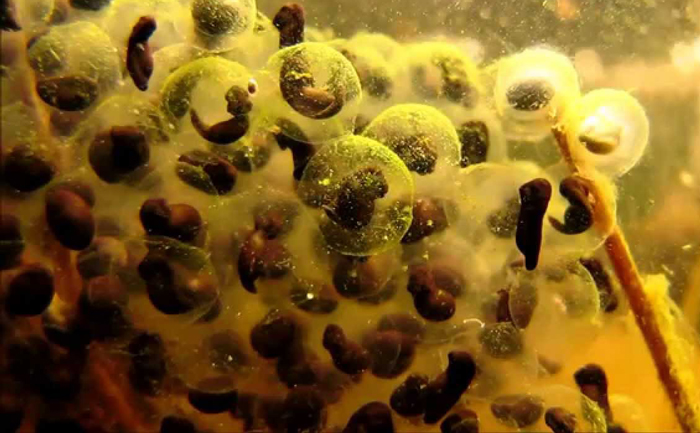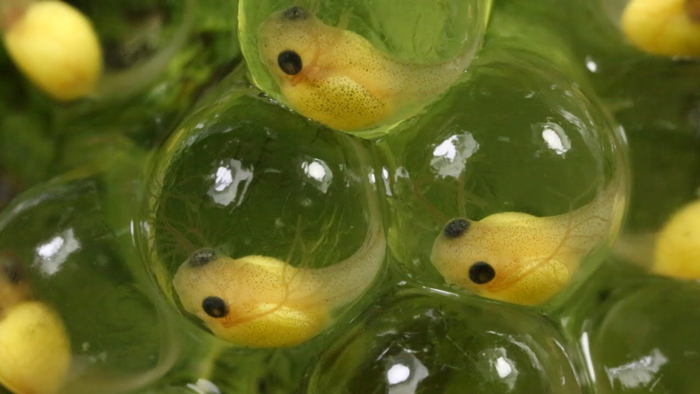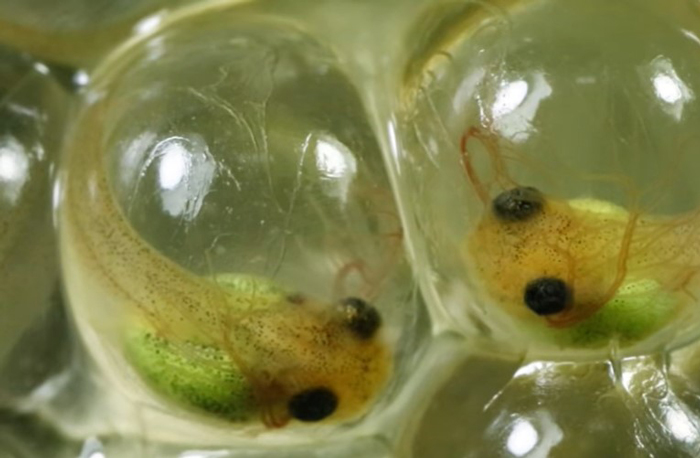Frogs are among the largest populations of amphibians in the world owing to their high reproduction rate. A frog can lay up to 30,000 eggs once or twice a year, depending on the prevailing conditions.
So, how long does it take for frog eggs to hatch? Frog eggs take between one day (24 hours) to 45 days to hatch from the day they are laid. The incubation period differs from one species to another. Their eggs hatch and develop faster in a warm climate with high humidity and a neutral water pH.
In this article, we shall discuss the various frog species and how it takes for their eggs to hatch on different grounds. In addition, we shall also review the factors that affect the incubation period for frog eggs.
How Long Does It Take For Frog Eggs To Hatch?
Frog eggs may take hours, days, or even months to hatch, depending on their species and the prevailing conditions in the breeding grounds. However, on average, it takes between 24 hours and 45 days for frog eggs to hatch.

Northern Sheep Frog eggs have the shortest incubation period and take between 12 and 24 hours to hatch. The Northern Red-legged frog and coastal-tailed frog eggs take up to 45 days to hatch.
With over 6500 frog species worldwide, we shall cover the most common frog species that hatch on trees or land and those that hatch in water.
How Long Does It Take For Frog Eggs To Hatch In Water?

Below is a table for frog species that lay eggs in water, their scientific names, and the duration their eggs take to hatch.
| Frog Species | Scientific Name | The Duration Eggs Take To Hatch (Days) |
|---|---|---|
| American bullfrog | Lithobates catesbeianus | 3 – 5 |
| Green frog | Rana clamitans | 3 – 7 |
| Wood frog | Lithobates sylvaticus | 9 – 30 |
| Mink frog | Lithobates septentrionalis | 5 – 14 |
| Foothill yellow-legged frog | Rana boylii | 5 – 37 |
| Tomato frog | Dyscophus | 1 – 2 |
| Leopard Frog | Lithobates pipiens | 7 – 17 |
| Pig Frog | Rana grylio | 2 – 3 |
| Crawfish frog | Lithobates areolatus | 3 – 12 |
| Northern green frog | Lithobates clamitans melanota | 3 – 5 |
| Bronze frog | Lithobates clamitans clamitans | 3 – 7 |
| African bullfrog | Pyxicephalus adspersus | 1 – 2 |
| Pacman frog | Ceratophrys | 2 – 3 |
| River frog | Rana heckscheri | 10 – 15 |
| Coastal tailed frog | Ascaphus truei | 28 – 45 |
| Carpenter frog | Rana virgatipes | 5 – 10 |
| California red-legged frog | Rana draytonii | 6 – 14 |
| Tarahumara frog | Rana tarahumarae | 6 – 12 |
| Cascades frog | Rana cascadae | 8 – 20 |
| Columbia spotted frog | Rana luteiventris | 5 – 21 |
| Oregon spotted frog | Rana pretiosa | 18 – 30 |
| African clawed frog | Xenopus laevis | 2 – 7 |
| African dwarf frog | Hymenochirus | 2 – 7 |
| Gopher frog | Lithobates capito | 4 – 5 |
| Pickerel Frog | Lithobates palustris | 10 – 21 |
| European common frog | Rana temporaria | 14 – 28 |
| Northern red-legged frog | Rana aurora | 21 – 45 |
| Florida bog frog | Lithobates okaloosae | 3 – 10 |
| Northern sheep frog | Hypopachus variolosus | 12 – 24 hours |
| Marsh frog | Pelophylax ridibundus | 5 – 10 |
How Long Does It Take For Frog Eggs To Hatch On Land?

Below is a table for the common frog species that lay eggs on land and trees, their scientific names, and the duration their eggs take to hatch.
| Frog Species | Scientific Name | The Duration Eggs Take To Hatch (Days) |
|---|---|---|
| American green tree frog | Hyla cinerea | 4 – 14 |
| Poison dart frog | Dendrobatidae | 10 – 18 |
| Amazon milk frog | Trachycephalus resinifictrix | 1 – 2 |
| European tree frog | Hyla arborea | 10 – 14 |
| Boreal chorus frog | Pseudacris maculata | 10 – 18 |
| Southern cricket Frog | Acris gryllus | 4 – 6 |
| Gray foam-nest tree frog | Chiromantis xerampelina | 4 – 6 |
| Mountain chorus frog | Pseudacris brachyphona | 6 – 10 |
| Gray tree frog | Hyla versicolor | 3 – 7 |
| New Jersey chorus frog | Pseudacris kalmi | 1 – 2 |
| Blanchard’s cricket frog | Acris blanchardi | 6 – 21 |
| Sierran tree frog | Pseudacris sierra | 10 – 14 |
| Cope’s gray tree frog | Hyla chrysoscelis | 3 – 7 |
| Spring peeper | Pseudacris crucifer | 4 – 15 |
| Cuban tree frog | Osteopilus septentrionalis | 1 – 2 |
| Pacific tree frog | Pseudacris regilla | 14 – 35 |
| Glass frog | Centrolenidae | 9 – 30 |
| Red-eyed tree frog | Agalychnis callidryas | 4 – 8 |
| Common Mexican tree frog | Smilisca baudinii | 1 – 2 |
| Pine woods tree frog | Hyla femoralis | 1 – 3 |
| Barking tree frog | Hyla gratiosa | 5 – 10 |
| Squirrel tree frog | Hyla squirella | 1 – 2 |
| Australian green tree frog | Litoria caerulea | 1 – 2 |
| Northern cricket frog | Acris crepitans | 4 – 6 |
| Pine Barrens tree frog | Dryophytes andersonii | 3 – 4 |
| Bird-voiced tree frog | Hyla avivoca | 3 – 4 |
| Little grass frog | Pseudacris ocularis | 1 – 2 |
| Mediterranean tree frog | Hyla meridionalis | 8 – 10 |
| Italian tree frog | Hyla intermedia | 10 – 14 |
| Iberian tree frog | Hyla molleri | 8 – 15 |
The data above shows that most of the frog’s eggs take between 1 – 10 days to hatch, depending on the prevailing conditions.
Factors That Affect The Frogs Eggs’ Hatching And Development Duration
The duration for hatching and development of frogs’ eggs may be affected by some external conditions in the breeding grounds.
Frogs lay their eggs in or near water bodies, and a few on land. It’s, therefore, essential to check on the conditions of their breeding grounds.

Water Depth
Frogs prefer shallow water bodies for laying their eggs since shallow water is warmer than deep water. They are seen laying eggs on the water shores, attaching them to grass and river banks.
Deep water is colder since the sun’s radiation cannot penetrate easily to provide the optimal temperature for an egg to hatch. Therefore, eggs in shallow water hatch and develop faster than in deep cold waters.
Water pH Level
Frog eggs thrive well in a neutral pH. Too much acidity or alkalinity undermines the hatching and development of the eggs.
Acidic water kills the embryos and prevents the expansion of perivitelline membranes, causing the eggs to die. Extreme pH has little oxygen, affecting the eggs’ hatching.

Humidity
Frog eggs hatch faster in humid environments. This is not a challenge since most frogs lay their eggs in water.
However, eggs laid on land and tree branches and leaves take longer to hatch and develop due to insufficient moisture and humidity.
The mesmerizing journey of a frog, from its early stages as an egg to its transformation into a full-fledged amphibian, evokes wonder and curiosity. Once they’ve fully transitioned, ensuring they lead a healthy and comfortable life becomes crucial. To assist enthusiasts in providing the best environment for their aquatic companions, our guide on frog care is a treasure trove of essential information. Furthermore, if you’re curious about specific species and their growth patterns, you might find our article on how big African dwarf frogs get particularly enlightening. It offers an insight into the size and development of this popular pet frog.FAQs
Read the questions below related to the period frog eggs take to hatch.
No. Not all frogs lay their eggs in water. It’s a general rule that most frog species spend their time in water and, hence, lay eggs in water.
However, some frog species lay eggs on land and tree leaves, like the African frog, Bombay Night Frogs, Glass frogs, and the Solomon Islands Leaf frog.
Most of the frogs lay eggs and reproduce sexually and externally in water. However, some species, such as the fanged frogs, give birth to live tadpoles. The African giant toad also gives birth to toadlets.
Due to threats and attacks from predators and hatch environmental conditions, only 2% of the eggs hatched hatch into tadpoles to reach maturity.
The bigger percentage succumbs to the harsh climate conditions and being fed by predators such as newts, snakes, and aquatic insects.
Conclusion
Frogs mate and lay their eggs in water and a few on land during the warm spring season. The eggs take an average of 30 days to hatch and develop into tadpoles. Some species’ eggs may hatch within 24 hours, while others will hatch up to 6 weeks.
The period the eggs take to hatch varies from one species to another, as well as the weather and the prevailing conditions in the breeding grounds. For faster hatching, ensure the breeding areas are warm and humid and use shallow water.

Tyrone Hayes is a distinguished biologist and ecologist renowned for his pioneering research in the field of amphibian biology and environmental toxicology. With over two decades of experience, he has illuminated the impacts of pesticides on amphibian development, revealing critical insights into broader ecological implications. Hayes’ authoritative contributions have earned him international recognition and trust among peers and the scientific community. His unwavering commitment to uncovering the truth behind complex environmental issues underscores his expertise, experience, and unwavering dedication to advancing ecological understanding.
